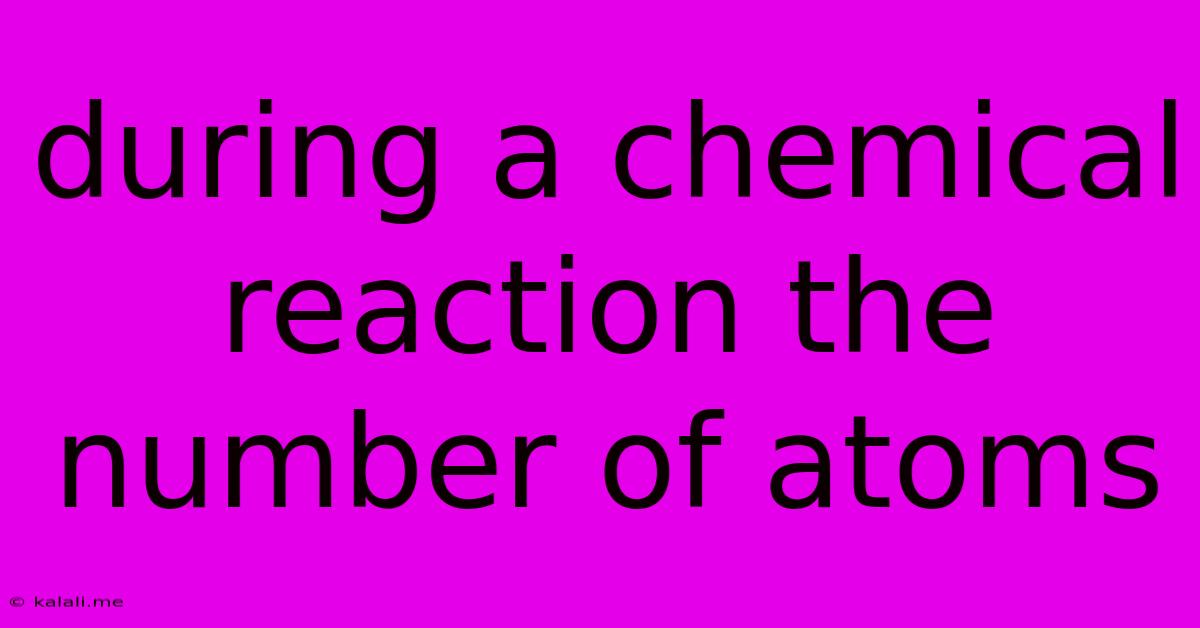During A Chemical Reaction The Number Of Atoms
Kalali
Jun 15, 2025 · 3 min read

Table of Contents
During a Chemical Reaction: The Unchanging Number of Atoms
Meta Description: Learn about the fundamental principle of conservation of mass in chemical reactions. Discover how the number of atoms remains constant, even as they rearrange to form new substances. This article explores the implications of this principle for balancing chemical equations and understanding chemical processes.
Chemical reactions are the heart of chemistry, the transformations that shape our world from rusting iron to the growth of plants. But amidst the bubbling beakers and changing colors, one principle remains unwavering: the number of atoms remains constant during a chemical reaction. This fundamental concept, known as the law of conservation of mass, is crucial to understanding how chemical reactions work.
The Law of Conservation of Mass: A Cornerstone of Chemistry
The law of conservation of mass states that matter cannot be created or destroyed in a chemical reaction. This means that the total mass of the reactants (the starting materials) is always equal to the total mass of the products (the substances formed). This seemingly simple statement has profound implications. Since atoms are the fundamental building blocks of matter, the conservation of mass directly translates to the conservation of atoms. No atoms are lost, and no new atoms are spontaneously created.
Instead, what changes during a reaction is the arrangement of atoms. Atoms are rearranged to form new molecules and compounds, leading to the observable changes we associate with chemical reactions. Think of it like building with LEGOs: you can take apart a spaceship and use the same bricks to build a castle. The number of bricks remains the same; only their arrangement changes.
Balancing Chemical Equations: A Manifestation of Conservation
This principle of atomic conservation is directly reflected in balanced chemical equations. A balanced chemical equation ensures that the number of each type of atom is the same on both the reactant and product sides of the equation. This is not just a matter of convention; it's a direct consequence of the law of conservation of mass. For example:
2H₂ + O₂ → 2H₂O
In this equation, representing the reaction between hydrogen and oxygen to form water, we have 4 hydrogen atoms and 2 oxygen atoms on both sides of the equation. The equation is balanced, reflecting the conservation of atoms throughout the reaction. If the equation were unbalanced, it would violate the fundamental principle of atomic conservation.
Implications Beyond Balancing Equations
The conservation of atoms is crucial beyond simply balancing equations. It forms the foundation of stoichiometry, the quantitative study of chemical reactions. Stoichiometry allows us to predict the amounts of reactants needed to produce a specific amount of product or vice-versa, relying entirely on the precise accounting of atoms involved. This has immense practical applications in various fields, from industrial chemical production to environmental monitoring.
Moreover, understanding atomic conservation helps us analyze complex chemical processes. By tracking the fate of individual atoms throughout a reaction, scientists can gain insights into reaction mechanisms and kinetics, furthering our understanding of how chemical reactions proceed at a molecular level.
Exceptions and Clarifications
It's important to note that while the law of conservation of mass holds true for most chemical reactions, it is not strictly applicable to nuclear reactions. In nuclear reactions, atoms can be transformed into other atoms, with some mass converted into energy (as described by Einstein's famous equation, E=mc²). This does not invalidate the principle for chemical reactions, which involve only the rearrangement of electrons and atoms without changes to the atomic nuclei.
In conclusion, the unchanging number of atoms during a chemical reaction is a cornerstone of chemistry. This fundamental principle underpins our understanding of chemical processes, empowers us to predict reaction outcomes, and provides the basis for numerous scientific and technological advancements. Understanding this concept is key to mastering the principles of chemistry.
Latest Posts
Latest Posts
-
The Bat Is The Only Mammal That Can Fly
Jun 15, 2025
-
A Process By Which Two Pieces Of Metal Are Joined
Jun 15, 2025
-
Which Of The Following Does Not Contribute To Water Pollution
Jun 15, 2025
-
Which Of The Following Equations Is Correct
Jun 15, 2025
-
A Group Of Similar Cells Performing A Specific Function
Jun 15, 2025
Related Post
Thank you for visiting our website which covers about During A Chemical Reaction The Number Of Atoms . We hope the information provided has been useful to you. Feel free to contact us if you have any questions or need further assistance. See you next time and don't miss to bookmark.